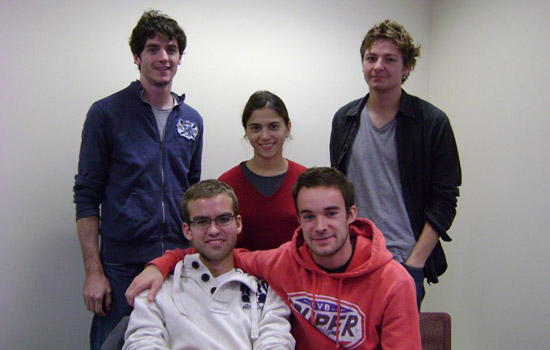Engineering and science’s universal language
French students make RIT home for six months through international partnership program
Michelle Cometa
There are many more similarities between colleges and college students than differences, said exchange students Romain Poirier, Vincent Michel, Pauline Martial, Sebastien Guilloux and Jean-Marie Belloir. The fifth-year engineering students from France took classes this fall and winter quarter in the Kate Gleason College of Engineering.
Thermodynamiques, the scientific concepts of heat and movement, are the same regardless of language.
A group of fifth-year engineering students from France discovered this and many more commonalities—from coursework to communities—during their study abroad experience at Rochester Institute of Technology.
The 11 students are from Institut National des Sciences Appliquees, or INSA, one of France’s top engineering schools, and Ecole Nationale de la Statistique et de L’Analyse de Information. Both universities are in Rennes, 200 miles west of Paris.
Attending RIT as part of a university agreement program, the students have been taking engineering, computing and science classes since the fall.
“We could really explore whatever we wanted, things we may not have been able to do in INSA,” says Pauline Martial, who is studying electrical engineering. Content is similar, but the way the material is presented is a bit different, she adds, with more tests and homework compared to longer in-class sessions in France and some more applications of concepts.
Sebastien Guilloux agreed. “Here you have to work a lot every week and the work is graded. In France, we only grade it at the end, so you must not miss the last exam in France,” he says, laughing. Guilloux, a first-time visitor to the U.S., is studying microelectronic engineering, quantum mechanics and MEMS/transistors.
Completing co-op experiences is required for the French students, just as it is for their American counterparts. They spend one month in a business in their first year, three months in the third year and six months during the fifth year.
The chance to learn and travel in another country is an exciting opportunity and a strategic plan for the students. Many of the companies they will work for expect employees to be bilingual.
“American people tell me, ‘Oh wow, you speak two languages fluently.’ But we need to speak English even if we want to work in a French company,” says Martial, who is studying electrical engineering and who has studied English since grade school. “Most of the time we have to speak English and have to know how to read English.”
RIT has nearly 70 global partnerships with universities such as INSA. The partnerships include joint degree programs, collaborative research between faculty and study abroad programs for students. The Kate Gleason College of Engineering and INSA have been academic exchange partners for more than 12 years. Students and faculty from each college participate in exchange programs, exploring not only classes and research but also cultures.
Some study takes place outside of the classroom. RIT hockey is nearly as exciting as European soccer games, says Guilloux, and adjusting to the weather has been pretty easy. Martial traveled to New York City and Washington, D.C., over breaks, remarking on how big the cities are compared to home. But all have been enjoying classes, classmates and their surroundings for the past few months. When they return to Rennes at the end of February, a final co-op, exams and graduation await them.
Joining Martial and Guilloux from the Institut National des Sciences Appliquees, and Ecole Nationale de la Statistique et de L’Analyse de Information, are Romain Poirier, Vincent Michel, Jean-Marie Belloir, Charles-Henri Babiaud, Karine Florent, Clement Gaultier, Cyrille Leblanc, Sarah Harmand Tran Quan and Antoine Nam.














